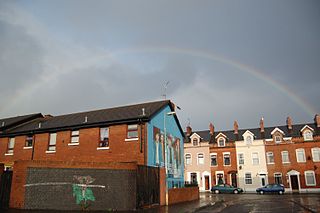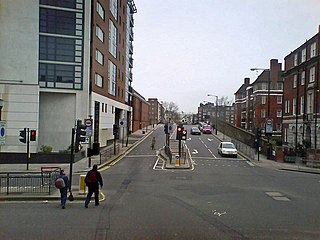
The Orange Volunteers (OV) or Orange Volunteer Force (OVF) is a small Ulster loyalist paramilitary group in Northern Ireland. It was formed in 1998 by loyalists who opposed the Belfast Agreement and the loyalist ceasefires. Over the following year it carried out a wave of bomb and gun attacks on Catholics and Catholic-owned properties in rural areas, but since 2000 has been relatively inactive. The group has been associated with elements of the Orange Order and has a Calvinist fundamentalist ideology. OV's original leader was Clifford Peeples. The OV are a Proscribed Organisation in the United Kingdom under the Terrorism Act 2000 and have been included on the U.S. State Department's, "Terrorist Exclusion List", since 2001.

An Phoblacht is a formerly weekly, and currently monthly newspaper published by Sinn Féin in Ireland. From early 2018 onwards, An Phoblacht has moved to a magazine format while remaining an online news platform. Editorially the paper takes a left-wing, Irish republican position and was supportive of the Northern Ireland peace process. Along with covering Irish political and trade union issues the newspaper frequently featured interviews with celebrities, musicians, artists, intellectuals and international activists. The paper sells an average of up to 15,000 copies every week. During the 1981 Irish hunger strike its sales soared to over 70,000 per week.

The Ambush at Drumnakilly was a military confrontation that took place at Drumnakilly in County Tyrone, Northern Ireland on 30 August 1988 during The Troubles, when a detachment of the Provisional IRA (IRA) was ambushed by the British Army.
The Troubles were a period of conflict in Northern Ireland involving republican and loyalist paramilitaries, the British security forces, and civil rights groups. They are usually dated from the late 1960s through to the Good Friday Agreement of 1998. However, sporadic violence continued after this point. Those that continued violence past this point are referred to as "dissident republicans and loyalists". The Troubles, internationally known as the Northern Ireland conflict, claimed roughly 3500 lives.
Jimmy Steele was an Irish republican militant and editor. He was one of the most prominent Irish Republican Army (IRA) men in Belfast after the Irish Civil War. Steele spent most of his life in jail as a result of his actions against British security forces.
The Troubles in Ardoyne lists incidents during the Troubles in the Ardoyne district of Belfast, Northern Ireland.

The 1973 Old Bailey bombing was a car bomb attack carried out by the Provisional IRA (IRA) which took place outside the Old Bailey Courthouse on 8 March 1973. The attack was carried out by an 11-person active service unit (ASU) from the Provisional IRA Belfast Brigade. The unit also exploded a second bomb which went off outside the Ministry of Agriculture near Whitehall in London at around the same time the bomb at the Old Bailey went off.
The Derry Brigade of the Provisional Irish Republican Army (IRA) operated in the city of Derry, Northern Ireland, and its surroundings during the Troubles. The Derry Brigade was one of the most active groups in the IRA.
On Tuesday evening 18 November 1975 an Irish Republican Army (IRA) unit nicknamed the Balcombe Street Gang, without warning, threw a bomb into Walton's Restaurant in Walton Street, Knightsbridge, London, killing two people and injuring almost two dozen others.
The 1994 Heathrow mortar attacks were a series of homemade mortar bomb attacks targeted at Heathrow Airport carried out by the Provisional IRA. Over a five-day period, Heathrow was targeted three times by the IRA, which fired 12 mortar rounds. Heathrow was a symbolic target due to its importance to the United Kingdom's economy, and much disruption was caused when areas of the airport were closed over the period due to the IRA attacks. The gravity of the incident was heightened by the fact that Queen Elizabeth II was being flown back to Heathrow by the RAF on 10 March.
The Battle of Lenadoon was a series of gun battles fought over a six day period from 9–14 July 1972 between the Provisional IRA and the British Army. It started on Thursday, 9 July 1972 in and around the Lenadoon Avenue area and spread to other places in Belfast. Loyalist paramilitaries and the Official Irish Republican Army were involved in some of the incidents. 28 people in total were killed in Belfast according to the CAIN: Sutton Index of Deaths. The violence ended a two-week truce between the forces of the British Government and the IRA.
The Balcombe Street Gang was a Provisional Irish Republican Army (IRA) active service unit (ASU) who carried out a bombing campaign in southern England in the mid-1970s. The majority of their attacks and attempted attacks took place in London and the rest in Surrey, Hampshire and Wiltshire. Between October 1974 and December 1975 they carried out approximately 40 bomb and gun attacks in and around London, sometimes attacking the same targets twice. The unit would sometimes carry out two or more attacks in one day; on 27 January 1975 they placed seven time bombs in London.
The Rose & Crown Bar bombing was a bomb attack carried out against a Catholic-owned pub in Belfast. The attack was carried out by the loyalist paramilitary group the Ulster Volunteer Force (UVF) just less than two weeks before the start of the Ulster Workers' Council strike of May 1974 which brought down the Sunningdale power sharing agreement and just 15 days before the UVF carried out the Dublin and Monaghan bombings which killed 34 and injured 300 people, the highest casualty rate in a single day during The Troubles in either Ireland or Britain.
On 25 and 27 November 1974 the Provisional Irish Republican Army (IRA) placed several bombs in pillar boxes and one in a hedge behind a pillar box. This was a new tactic used by the IRA in England, although a similar tactic had been used in Northern Ireland during The Troubles several times previously. 40 people were wounded from five explosions in several districts.

In the late hours of 3 February and the early hours of 4 February 1973, six men, all of whom were Catholics, were shot and killed in the New Lodge area of north Belfast:

On 2 December 1984, a four-man Provisional Irish Republican Army (IRA) active service unit was ambushed by a British Army Special Air Service team while attempting to bomb a Royal Ulster Constabulary patrol who they had lured to Drumrush Lodge Restaurant. Two IRA volunteers and one SAS soldier were killed during the action.
The Central Bar bombing was a bomb attack on a pub in the town of Gilford near Portadown in County Down in Northern Ireland on 31 December 1975. The attack was carried out by members of the Irish National Liberation Army (INLA) using the covername "People's Republican Army" although contemporary reports also said the "Armagh unit" of the "People's Republican Army" had claimed responsibility. Three Protestant civilians were killed in the bombing.
The Official IRA's Belfast Brigade was founded in December 1969 after the Official IRA itself emerged in December 1969, shortly after the beginning of the Troubles, when the Irish Republican Army split into two factions. The other was the Provisional IRA. The "Officials" were Marxist-Leninists and worked to form a united front with other Irish communist groups, named the Irish National Liberation Front (NLF). The Brigade like the pre-split IRA brigade before the split had three battalions, one in West Belfast, one in North Belfast and the third in East Belfast. The Belfast Brigade was involved in most of the biggest early confrontations of the conflict like the Falls Curfew in 1970, the battles that followed after the introduction of Internment without trial in 1971 and Volunteers joined forces with the Provisional brigade to fight the British Army and UVF during the Battle at Springmartin in 1972. The first Commanding Officer (CO) of the brigade was veteran Billy McMillen who fought during the IRA Border Campaign. Shortly after the death of Official IRA Belfast "Staff Captain" Joe McCann in April 1972, the battalion structure of the brigade was done away with and command centralized under McMillen.
The following is a timeline of actions during The Troubles which took place in the Republic of Ireland between 1969 and 1998. It includes Ulster Volunteer Force bombings such as the Dublin and Monaghan bombings in May 1974, and other Loyalist bombings carried out in the 1970s, 80s & 90s, the last of which was in 1997. These attacks killed dozens of people and injured hundreds more. Also actions carried out by Irish Republicans including bombings, prison escapes, kidnappings, and gun battles between the Gardaí (police) and the Irish Defence Forces against Republican gunmen from the Irish National Liberation Army, the Provisional Irish Republican Army, and a socialist-revolutionary group, Saor Éire. These attacks killed a number of civilians, police, soldiers, and Republican paramilitaries.

The Chelsea Barracks bombing was an attack carried out by a London-based Active Service Unit (ASU) of the Provisional IRA on 10 October 1981, using a remote-controlled nail bomb. The bomb targeted a bus carrying British Army soldiers just outside Chelsea Barracks. The blast killed two civilians and injured 40 people, among them 23 soldiers.






